Loose Ends -- June 3, 2008
by Pete Smoyer
One of the things that I’ve always loved to do, even long before meeting Ali, is go for long hikes through wooded trails with my dog.
It used to be my English setter, Maddy, who would accompany me on these walks. After she turned three, I hardly ever took a leash with me. Much of the time, Maddy and I stayed pretty close together. But, when there were pheasants, turkeys, or chukkers around, Maddy could disappear for 10 - 15 minutes. I’d often have to turn back to find her. The good thing about birds is that they'd usually avoid the dog by going up a tree. Maddy would usually find the bird in the tree and bark until I got there. This driving interest in birds usually meant she wouldn't get into trouble when we run into other people or dogs on our adventures.
As it turns out, these are the quarries that gave Slatington its name. And now that Washington Township near Slatington is home, it’s not surprising that Bing, Acacia and I have discovered these trails. And since it’s been at least 10 years since I first saw these trails from the turnpike, there is significantly more vegetation than I remember.
Since Ali’s been pregnant for most of the time the two dogs and I have been discovering these trails, she hasn’t been up for hiking steep slippery rock-strewn trails that are the refuse banks of the slate industry. But what I’ve learned really amazes me: the two dogs don’t stray far and are more interested in staying together than running off, even when they spot a likely rabbit or groundhog.
How much of this is the result of training and how much is instinct is one of the questions being raised here. As you know from reading these blogs and Ali’s books, Acacia, and in my opinion, Bing too, is a reactive dog. They often respond to stimuli in ways that we believe are inappropriate or excessive for the circumstances.
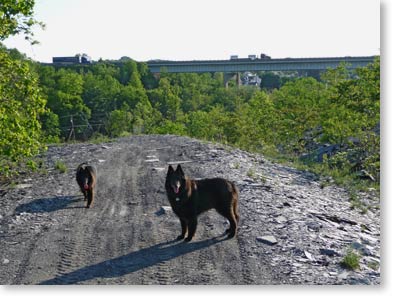
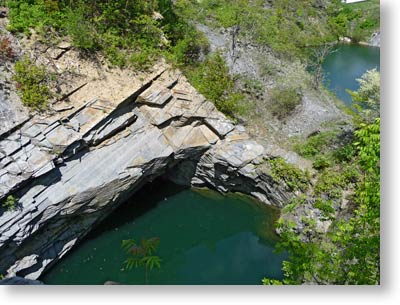
Keeping track of their person
While walking these trails, Bing and Acacia are constantly checking in from a distance to see which way I’m heading. They adjust their courses accordingly and enthusiastically. They want to scout ahead. Fortunately, ahead is generally the direction I’m traveling. If I stop, they usually come back to me, looking for direction or treats. When I pause to inspect something new, they usually hang around. Sometimes they like to chase a deer, squirrel, or groundhog. But they’re usually out of sight for 30 seconds, 2 minutes max.
Unlike Maddy, they’re not looking to get ahead to find a bird. As herding dogs, I might like to believe they’re following the lead of the shepherd and scouting ahead to keep the herd safe while moving in the right direction. OK, there’s no herd.
So Maddy wasn’t a reactive dog, but she also wasn’t an attentive dog. Usually, if the Belgians get themselves and Ali and me in trouble, I believe it’s because they’re following some instinct that is prevalent in the breed.
Pete
Comments about this blog, email pete@e-production.net (your comments may be posted).
Return to the Main Blog Page.
Send email to Ali Brown
The shards of slate on the outside edges sound like broken glass when you walk on them. In the background you can see trucks
on the PA Turnpike .
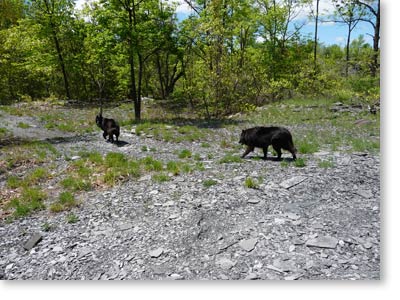
You can see Bing leading the way, but looking back to make sure
it's still the right way to go.
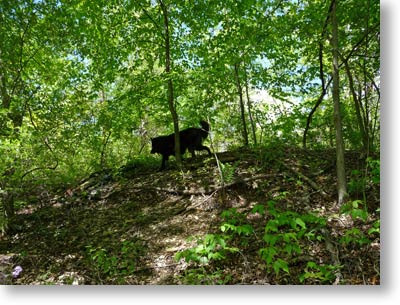
The point is I’ve never had a more enjoyable time with dogs than learning these new trails. We’ve found many interesting formations, lots of man-made walls and cliffs that are now overgrown with whatever vegetation can get a hold in the rocky soil. There seems to be a mutual interest in these walks. The dogs make suggestions of which way to go. Bing will stand at the entrance to one trail, stop and stare at me, as if he knows something I don’t. And sometimes he does.
As seen in the pictures, the walk usually follows this scenario: leave the car, go in the stream for a drink of clean water, walk through the first flat rocky area (a future housing development?), hike and discover the trails, turn around when we get to the turnpike, walk down to the asphalt covered Slate Heritage Trail, swim for treats, play, watch motorcycles on the motocross course, go on leash and walk the rest of the way back to the car. It’s a real group experience.
My concern is that there are fresh two-wheeler and four-wheeler tracks on many of these trails. We try to go for walks on days and at times when we expect no one else to be around, and we’ve been lucky. When summer comes and kids are out of school we’ll probably avoid them. (story continues below)
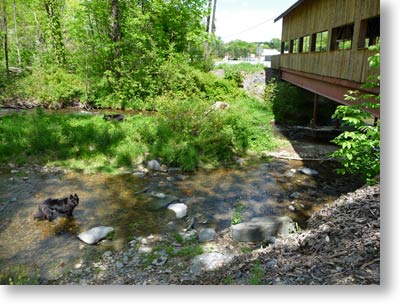
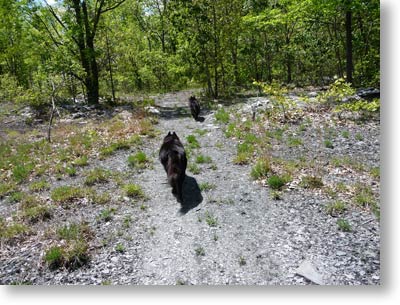
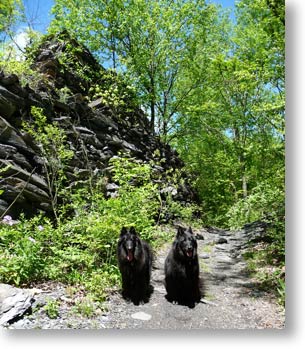
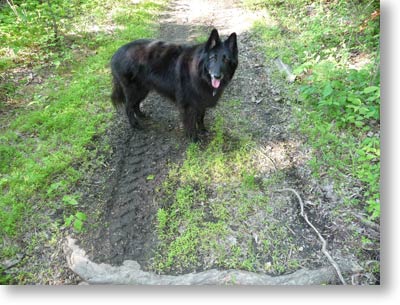
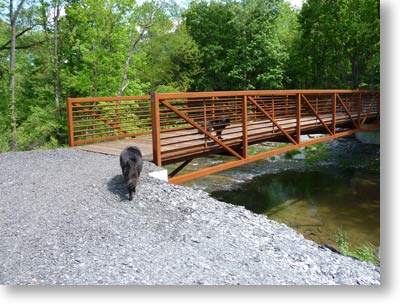


Brussels Sprout or Bicycles
The heading above is an aptly named chapter from Ali’s book, Scaredy Dog! Bing loves to chase bikes, and that is one case where he will run a great distance away from us. But even there, he’ll just run off, “Bark, bark, bark,” and return. Now that Ali and I recognize this, we’ve developed the “bikes” recall. We’ve associated the word bikes with treats. By yelling, "Bikes!", Ali and I can alert each other that there are bikes present, and it gets Bing and Acacia to return to us for treats. Announcing, “Treats,” to the dogs is sometimes necessary to reinforce the return behavior. But it’s working consistently now.
Getting Bing to return and having him back on leash doesn’t diminish his desire to chase the bike. When we see him looking to far ahead after using the “bikes” cue, we realize he’s still focused on the bikes that may by now be out of view. The funny thing is, if we let him off leash with bikes on the brain, and he runs off, and returns, Acacia will “beat him up” for having run off.
Now, all this said, Ali will dispute whether or not Bing’s continued refocusing on us during our walks is a herding instinct or a learned behavior. During most of Bing’s three years, Ali would hide from the dogs any time they’d stray ahead too far for her liking, either behind a tree or in some brush. It doesn’t matter if I also try to hide or just walk along in clear sight, the dogs will always look for Ali. But it is my belief that that has only reinforced the behavior, not created the behavior. No amount of hiding from Maddy would have gotten her to seek me out when she’s onto something else.
Given the choice of treats or bikes, Bing will choose treats. That is a learned behavior. He still doesn’t respond to Brussels sprouts. And the only reason he likes broccoli is because Acacia likes it.
It seems to me that reactivity is a human problem, not the dog’s problem. Aggression is the human’s problem and the dog’s problem. My definition for reactivity would be: the coming to fore of the dog’s instincts when it’s inappropriate for humans.
When Acacia nips the contractor who comes through the gate to the house – even though she was previously “playing” with him near the pole barn – that really is appropriate behavior. She wasn’t aggressive, it wasn’t without warning, and there was no second bite. Her nip is a warning shot. She’s intimidating like that. It was inappropriate for the contractor to come through the gate.
Bing’s behavior also shows how reactivity requires management. Even if we get him to return to us instead of chasing bikes, he has to be on leash until his attention shifts from the bikes he just saw. Short of being on a six-foot leash at all times, Bing and Acacia require management 100% of the time to avoid problems. Even after watching dozens of Ali’s reactive dog classes, I used to think that talking about management was just Ali’s copout way of saying she didn’t know how to change one of a dog’s behavior problems. Now I believe it’s a way of saying, “This dog is behaving appropriately, your job as owner is to manage that appropriate behavior and use it to your best advantage.” You may not ever get the dog not to nip the contractor as he comes through the gate. Even when you’re home and you want a contractor to come through the gate. But you can get the dog's attention before he does so, put her on leash, let her sniff him and grumble about his presence, and then she’s fine. She’s done her job. When it’s late at night and the contractor comes through the gate when he’s not supposed to, and she makes a scene, she’s also doing her job.
And that’s what makes it so hard to refine a reactive dog’s behavior. It’s not really bad behavior, it’s just inappropriate for the situation, or for your lifestyle. Instincts make the dog fun, training makes the dog dependable, and management makes it possible to handle the dog in difficult situations. (continued below)
Two side notes:
#1 Even Acacia’s behavior problem with Labrador retrievers could also be interpreted as appropriate for a herding dog. One day, while Acacia, Bing and I were walking up the Appalachian Trail near the Lehigh Gap, out of nowhere, a large black dog came happily bounding down the trail towards us. Acacia’s reaction (there’s the word) was to grab the approaching dog by the back of the neck, actually snapping off its collar and breaking one of her own lower canines in the process, and send the dog running off. Her reaction might have been greatly appreciated if the approaching dog had been one of the more aggressive breeds.
#2 Bing’s issues with loose leash walking always make me think of Pippa. Pippa was a friend’s Belgian sheepdog that Ali and I would look after when her owners went on trips or vacations. We were always concerned that Pippa would run off if we let her off leash while in a park. Pippa was always a pain-in-the-butt to walk, because she constantly pulled as hard as she could on the leash. So much so that walking her caused shin splints. Bing is from the same breeder as Pippa, and if he provides any answers to the question of running off, it would be “no.” The leash is never long enough for Bing either. Bing always needs to be more than 50 feet ahead to be doing his job. Loose leash walking, to human standards, has to be trained separately.
Technical note: All pictures and video on this page were shot with a Panasonic TZ5 point and shoot camera.


